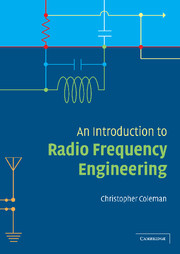Book contents
- Frontmatter
- Contents
- List of figures
- Preface
- Acknowledgements
- 1 Basic concepts
- 2 Frequency selective circuits and matching
- 3 Active devices and amplifiers
- 4 Mixers, modulators and demodulators
- 5 Oscillators and phase locked loops
- 6 Transmission lines and scattering matrices
- 7 Power amplifiers
- 8 Filters
- 9 Electromagnetic waves
- 10 Antennas
- 11 Propagation
- 12 Digital techniques in radio
- Index
6 - Transmission lines and scattering matrices
Published online by Cambridge University Press: 05 June 2012
- Frontmatter
- Contents
- List of figures
- Preface
- Acknowledgements
- 1 Basic concepts
- 2 Frequency selective circuits and matching
- 3 Active devices and amplifiers
- 4 Mixers, modulators and demodulators
- 5 Oscillators and phase locked loops
- 6 Transmission lines and scattering matrices
- 7 Power amplifiers
- 8 Filters
- 9 Electromagnetic waves
- 10 Antennas
- 11 Propagation
- 12 Digital techniques in radio
- Index
Summary
In propagating through free space, radio waves will suffer a reduction in amplitude as they spread outwards from the source. When a transmission must reach a large number of geographically dispersed receivers, such as in broadcast radio, there is little that can be done about this loss. If it is only required to reach one receiver, however, it is desirable to transmit all the energy to this one device. A structure for achieving this is known as a transmission line. Such structures will normally have a small uniform cross-section and can be constructed so that the loss along the line is extremely small. Transmission lines allow efficient and unobtrusive transmission over long distances. Two of the most common varieties of transmission line are the coaxial cable and the twin parallel wire. This chapter considers a simple lumped circuit model of such transmission lines and describes some important applications of these structures. The study of transmission lines leads very naturally to the concept of the reflection coefficient, a concept that provides an alternative description of impedances. Reflection coefficients generalise to the concept of scattering matrices which themselves provide an alternative means of describing multiport networks. The present chapter introduces the basic idea of the scattering matrix and shows howit can be applied to the design of small signal amplifiers at high frequencies.
The transmission line model
Figure 6.1 shows the construction of two important transmission lines, the coaxial cable and twin parallel wire.
- Type
- Chapter
- Information
- An Introduction to Radio Frequency Engineering , pp. 132 - 170Publisher: Cambridge University PressPrint publication year: 2004



